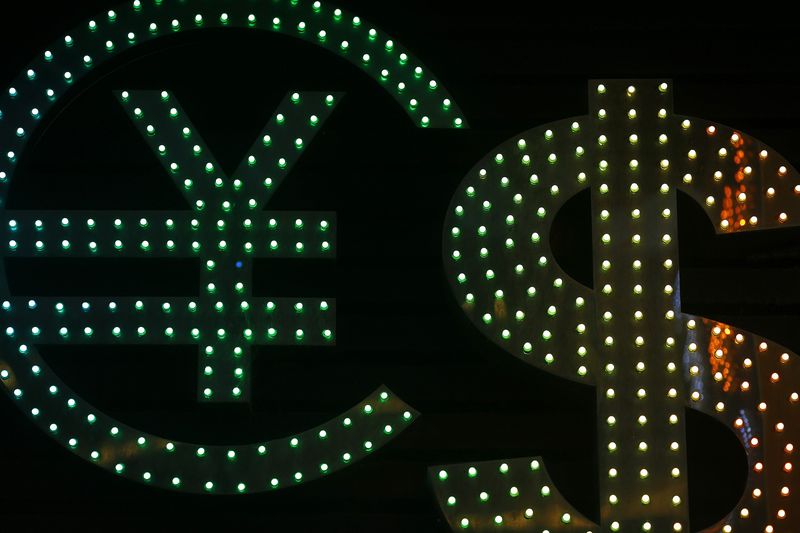* Fed's Powell says may take over 3 years to hit inflation aim
* UST yields keep rising, 10-year yields above 1.4%
* ECB uneasy with yield rise, Japan yields above BOJ target
By Sujata Rao and Dhara Ranasinghe
LONDON, Feb 24 (Reuters) - Central bankers worldwide have been unequivocal: There are no plans to cut back on money-printing any time soon, let alone raise interest rates.
Markets don't seem to be buying it.
U.S. 10-year Treasury yields rose on Wednesday to one-year highs above 1.4% US10YT=RR , extending this year's near 50 basis-point jump that has dragged up sovereign borrowing costs in Europe, Japan and elsewhere.
The reckoning is that the spending step-up by U.S. President Joe Biden's administration and post-vaccine economic reopening will fuel a global growth-inflation rebound, forcing central banks to "taper" or withdraw stimulus ahead of schedule.
A brighter outlook may indeed justify higher yields. But what has started to spook markets is a sudden move up in so-called real yields, or returns in excess of inflation. That shift can tighten financial conditions, suck cash from stock markets and in general, hamper the recovery. spooking policymakers, too. From the Federal Reserve's Jerome Powell to New Zealand's Adrian Orr, many have weighed in this week to stress policy will remain loose for some time.
But the mantra they have chanted for years seems now to be falling on deaf ears.
Powell, the world's most powerful central banker, knocked yields just a couple of bps lower even after commenting that the inflation target was more than three years away. zone yields only briefly heeded European Central Bank chief Christine Lagarde's warning on Monday that the bank was "closely monitoring" the recent rise in yields. reason, according to ING Bank is that markets are pricing "with an increasing degree of conviction" the end of ultra-easy policies.
"Market confidence in the strength of the U.S. recovery is so strong and widespread that the tapering boat has sailed already," they said, predicting "tapering" to happen by the end of 2021, earlier than the early 2022 predicted by Fed surveys.
"We expect consensus is converging to our view," they added.
Money markets show investors expect a Fed rate rise next year; some bet on an even earlier move. Euro-dollar futures suggest a roughly 64% chance of a 25 basis-point rate hike by the end of 2022 EDc1 . A week ago it was seen at 52%.
If travel, dining out and shopping fully resume in coming months, it could unleash trillions of dollars in pent-up savings worldwide. Just in the United States, personal savings totaled $2.38 trillion at a seasonally adjusted annual rate in December, higher than at any time before the pandemic.
That makes it an inflection point of sorts for the economy, according to April LaRusse, head of fixed income investment specialists at Insight Investment. At times like this, even strong forward guidance can fall flat, she said.
"Markets hear central bankers saying 'Stop it, markets, you are going too far', but they are worrying central banks might change their mind as new data emerges," LaRusse said.
"Markets are saying: 'Yes, we believe what you are saying, but conditions could change and could necessitate a change of policy'."
ELSEWHERE
It's a similar picture elsewhere.
In New Zealand, Orr's highlighting of potential downside risks to the economy contrasted with the buoyant picture painted by data. yields shrugged off his comments to hit 11-month highs. More importantly, overnight index swaps (OIS), instruments allowing traders to lock in future interest rates, have started pricing a small possibility of an end-2021 rate hike NZ10YT=RR .
Not long ago it was seen cutting rates below 0%.
BNY Mellon noted across-the-board rises in one-year forward inflation swaps -- essentially gauges of future inflation -- from Canada to Australia.
"Risks are now more toward further removal of easing prospects," they added.
There is of course the possibility that the pledges to keep policy ultra-loose in the face of recovering growth only fan inflation expectations further. So, could markets force central banks to act rather than just jawboning?
Here the Fed faces less of a dilemma than its peers.
Japan's 10-year yields are near the highest since late 2018 at 0.12% JP10YTN=JBTC , posing credibility issues for a central bank that aims to hold yields around 0%.
The ECB too, already struggling to lift growth and inflation, may have to step up bond purchases under its emergency asset-purchase programme to combat rising yields.
"At the moment it's a tension between markets and central banks rather than a conflict, though that might come," said Jacob Nell, head of European economics at Morgan Stanley (NYSE:MS).
"The attitude of the Fed is that if markets think growth is stronger than we do then that's fine, it will help growth and inflation expectations. So the Fed won't fight the market -- it just doesn't believe it."
<^^^^^^^^^^^^^^^^^^^^^^^^^^^^^^^^^^^^^^^^^^^^^^^^^^^^^^^^^^^ Who's uncomfortable with rising bond yields?
https://tmsnrt.rs/2ZLIODM Powell reassures bond markets but yields stay high
https://tmsnrt.rs/3undCJb US savings
https://tmsnrt.rs/2NXprVL
^^^^^^^^^^^^^^^^^^^^^^^^^^^^^^^^^^^^^^^^^^^^^^^^^^^^^^^^^^^>
